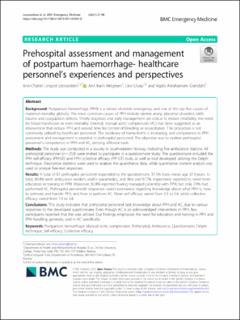Prehospital assessment and management of postpartum haemorrhage– healthcare personnel’s experiences and perspectives
Peer reviewed, Journal article
Published version

View/
Date
2021Metadata
Show full item recordCollections
Abstract
Background
Postpartum hemorrhage (PPH) is a serious obstetric emergency, and one of the top five causes of maternal mortality globally. The most common causes of PPH include uterine atony, placental disorders, birth trauma and coagulation defects. Timely diagnosis and early management are critical to reduce morbidity, the need for blood transfusion or even mortality. External, manual aortic compression (AC) has been suggested as an intervention that reduce PPH and extend time for control of bleeding or resuscitation. This procedure is not commonly utilized by healthcare personnel. The incidence of home-births is increasing, and competence in PPH assessment and management is essential in prehospital personnel. The objective was to explore prehospital personnel’s competence in PPH and AC, utilizing different tools.
Methods
The study was conducted in a county in South-eastern Norway, including five ambulance stations. All prehospital personnel (n = 250) were invited to participate in a questionnaire study. The questionnaire included the PPH self-efficacy (PPHSE) and PPH collective efficacy (PPHCE) tools, as well as tool developed utilizing the Delphi technique. Descriptive statistics were used to analyze the quantitative data, while quantitative content analysis was used to analyse free-text responses.
Results
A total of 87 prehospital personnel responded to the questionnaire, 57.5% male, mean age 37.9 years. In total, 80.4% were ambulance workers and/or paramedics, and 96.6 and 97.7% respectively reported to need more education or training in PPH. Moreover, 82.8% reported having managed patient(s) with PPH, but only 2.9% had performed AC. Prehospital personnels’ responses varied extensively regarding knowledge about what PPH is, how to estimate and handle PPH, and how to perform AC. Mean self-efficacy varied from 3.3 to 5.6, while collective efficacy varied from 1.9 to 3.8.
Conclusions
This study indicates that prehospital personnel lack knowledge about PPH and AC, due to various responses to the developed questionnaire. Even though AC is an acknowledged intervention in PPH, few participants reported that this was utilized. Our findings emphasize the need for education and training in PPH and PPH handling generally, and in AC specifically.